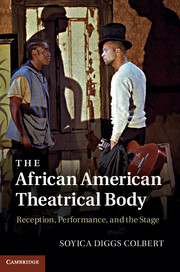Book contents
- Frontmatter
- Contents
- Illustrations
- Acknowledgements
- Overture: rites of reparation
- Chapter 1 Repetition/reproduction: the DNA of black expressive culture
- Chapter 2 Recuperating black diasporic history
- Chapter 3 Reenacting the Harlem Renaissance
- Chapter 4 Resisting shame and offering praise and worship
- Chapter 5 Resisting death: the blues bravado of a ghost
- Chapter 6 Rituals of repair
- Chapter 7 Reconstitution
- Epilogue Black movements
- Notes
- Bibliography
- Index
Chapter 3 - Reenacting the Harlem Renaissance
Zora Neale Hurston's Color Struck
Published online by Cambridge University Press: 05 November 2011
- Frontmatter
- Contents
- Illustrations
- Acknowledgements
- Overture: rites of reparation
- Chapter 1 Repetition/reproduction: the DNA of black expressive culture
- Chapter 2 Recuperating black diasporic history
- Chapter 3 Reenacting the Harlem Renaissance
- Chapter 4 Resisting shame and offering praise and worship
- Chapter 5 Resisting death: the blues bravado of a ghost
- Chapter 6 Rituals of repair
- Chapter 7 Reconstitution
- Epilogue Black movements
- Notes
- Bibliography
- Index
Summary
Bodies erect, prancing smoothly, the dancers draw the whole stage, well, almost the whole stage, and the entire audience into frenzy. For seven minutes the characters in Zora Neale Hurston's Color Struck (1926) cakewalk across the stage. There is no evidence that Color Struck was ever performed. My reading of the play, however, reflects the staging implicit in most dramatic work. The climactic cakewalk in the middle of the play eclipses the struggle that leads up to it, emphasizing what has been achieved. The beautiful carefree dancing, read outside of its historical context, seems to have no political import. In “On Freedom and the Will to Adorn: Debating Aesthetics and/as Ideology in African American Literature,” Cheryl Wall explains that in Richard Wright's 1937 review of Hurston's Their Eyes Were Watching God Wright linked “Hurston to a politics he deemed reactionary and to a quest for the beautiful which, to him, served no ‘serious’ purpose.” Wright established a binary opposition between Hurston's choice of subject matter – focusing on the abundance of beauty in African American culture – and what he deemed serious political art. In this chapter, I question the oppositional relationship between the quest for the beautiful and political empowerment through black performance. Foreshadowing the conceptual frame Hurston establishes in “Characteristics of Negro Expression” (1934), the cakewalking in Color Struck presents a performance practice that embodies the conflicts of the community imagined in the play and reflects the larger struggle the New Negro community faces over its racial and national identities.
Color Struck's plot is deceptively simple. The play depicts a classic love triangle that develops within a group of young people from Jacksonville, Florida on their way to a cakewalking contest in St. Augustine, Florida. Color Struck is set at the turn of the century, the height of cakewalking in America and Europe. Spearheaded by George Walker, his vaudevillian partner Bert Williams, Stella Wiley, and Ada (Aida) Overton Walker, the duos transformed the cakewalk from a dance enslaved Africans performed for themselves and at the behest of slave masters into an international craze; as Walker describes it, they “were able to put a premium on Cake-walking, and at one time, in 1902 and 1903 . . . had all New York and London doing the Cake-walk.” Most theorists, including Elin Diamond and Jacqui Malone, describe the cakewalk as a strut. Additionally Malone specifies the improvisational quality implicit in the dance and in all forms of black vernacular dance. While the erect torso and extended leg characterize the dance, descriptions and modern interpretations of it allow for much variation. Leading up to the contest depicted in Color Struck, the female protagonist, Emmaline (called Emma) consistently fights for her boyfriend John's attention. While John consoles and chides dark-skinned Emma for what he characterizes as her unfounded jealousy, he also encourages the affection of light-skinned Effie. Along with the play's commentary on the politics of colorism, Color Struck adds a twist to this classic love triangle by interrupting the progress of the plot with dancing scenes. In fact, the emotional climax of the play occurs in scene iii, which presents the cakewalking contest, a purposeful reordering of early twentieth-century revue sketches that concluded with a “jubilant” cakewalk. If the action that leads up to the contest seems to depict Emma as a jealous melodramatic girlfriend, the third and fourth scenes of the play arrest that judgment. From the climactic third scene to the structural critique Emma makes at the end of the play, Color Struck focuses on the costs of modern “progress.”
- Type
- Chapter
- Information
- The African American Theatrical BodyReception, Performance, and the Stage, pp. 91 - 122Publisher: Cambridge University PressPrint publication year: 2011



